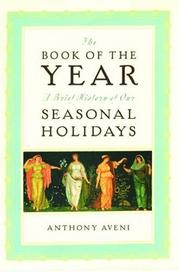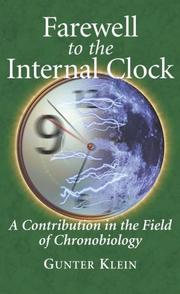| Listing 11 - 17 of 17 | << page >> |
Sort by
|

ISBN: 1280482125 1423761235 0195348699 1602567476 9781423761235 9781280482120 9786610482122 6610482128 9781602567474 0195150244 9780195150247 0197711855 9780195348699 Year: 2023 Publisher: Oxford : Oxford University Press,
Abstract | Keywords | Export | Availability | Bookmark
 Loading...
Loading...Choose an application
- Reference Manager
- EndNote
- RefWorks (Direct export to RefWorks)
Anthony Aveni looks closely at our holidays, at how we respond to them, the traditions that have been handed down, & he investigates the origins of these traditions, often taking them back to pre-Christian & even magical roots. He describes a pattern & a process behind our holiday cycle.
Holidays --- Rites and ceremonies. --- Archaeoastronomy. --- Biological rhythms. --- Chronobiology. --- Biological time --- Biology --- Time --- Biological clocks --- Biorhythms --- Endogenous rhythms --- Living clocks --- Rhythms, Biological --- Chronobiology --- Cycles --- Pacemaker cells --- Archeoastronomy --- Astroarchaeology --- Astronomy, Prehistoric --- Prehistoric astronomy --- Astronomy --- Ceremonies --- Cult --- Cultus --- Ecclesiastical rites and ceremonies --- Religious ceremonies --- Religious rites --- Rites of passage --- Traditions --- Ritualism --- Manners and customs --- Mysteries, Religious --- Ritual --- Legal holidays --- National holidays --- Days --- Hours of labor --- Memorials --- Anniversaries --- Fasts and feasts --- Vacations --- History. --- Periodicity --- Rites and ceremonies

ISBN: 1281337412 9786611337414 0387693580 0387403159 1489991956 Year: 2007 Publisher: New York : Springer,
Abstract | Keywords | Export | Availability | Bookmark
 Loading...
Loading...Choose an application
- Reference Manager
- EndNote
- RefWorks (Direct export to RefWorks)
Nearly everything making up what we call the “environment” of a plant has an infuence on the way it grows. Sunlight, te- perature, moisture contents of soil and atmosphere and vib- tions are all obvious examples of environmental components, and transient variations in their amount or intensity lead the plant to manifest more or less immediate responses. Small changes in carbon dioxide level in the atmosphere can even have effects, but these take a longer time to be registered – at least those that are visible, albeit at the microscopic level. Plants meet the challenges of the environment by means of acclimation. In this respect, plants are notable for the pl- ticity of their development. However, where morphological or physiological plasticity is no longer an option, the responses would be by means of adaptations as a result of genetic - lection or genetic “assimilation” (Waddington 1957). Thus, a feature that was once a facultative transient response to an environmental perturbation becomes a constitutive charac- ristic of plant structure or function. It is in this way that the environment continually molds the way in which plants de- lop, and also defnes the areas upon planet Earth where they will thrive.
Chronobiology. --- Biological time --- Biology --- Time --- Life sciences. --- Cytology. --- Medicine. --- Neurosciences. --- Animal behavior. --- Life Sciences, general. --- Cell Biology. --- Biomedicine general. --- Behavioral Sciences. --- Popular Science in Nature and Environment. --- Animals --- Animals, Habits and behavior of --- Behavior, Animal --- Ethology --- Animal psychology --- Zoology --- Ethologists --- Psychology, Comparative --- Neural sciences --- Neurological sciences --- Neuroscience --- Medical sciences --- Nervous system --- Clinical sciences --- Medical profession --- Human biology --- Life sciences --- Pathology --- Physicians --- Cell biology --- Cellular biology --- Cells --- Cytologists --- Biosciences --- Sciences, Life --- Science --- Behavior --- Cell biology. --- Behavioral sciences. --- Nature. --- Environment. --- Biomedicine, general. --- Health Workforce --- Balance of nature --- Bionomics --- Ecological processes --- Ecological science --- Ecological sciences --- Environment --- Environmental biology --- Oecology --- Environmental sciences --- Population biology --- Ecology

ISBN: 9786611043292 128104329X 0387454470 0387454454 0387454446 Year: 2007 Publisher: New York, N.Y. : Springer,
Abstract | Keywords | Export | Availability | Bookmark
 Loading...
Loading...Choose an application
- Reference Manager
- EndNote
- RefWorks (Direct export to RefWorks)
Over the past twenty-five years, the effects of the spatial distribution and scaling of resources on animal populations have been increasingly studied in wildlife biology, landscape ecology, conservation biology, and related fields. However, spatial patterns change over time. In Temporal Dimensions of Landscape Ecology: Wildlife Responses to Variable Resources, the authors discuss the effects that temporal changes in resources have on animal populations. Resource availability and quality are not distributed homogeneously over time, depending for example on predictable changes in seasons, mating and birthing cycles, unpredictable resource pulses and weather-related phenomena, ecological disturbances, and historical legacies. Temporal Dimensions of Landscape Ecology brings together chapters that address the idea of current as well as historical temporal influences on resource availability, quality, and distribution. The authors draw attention to the neglected temporal issues so important to understanding species and community responses. This book will be of interest to both wildlife and conservation students and practitioners working with temporal and spatial scale issues.
Landscape ecology. --- Niche (Ecology) --- Adaptation (Biology) --- Spatial ecology. --- Chronobiology. --- Ecology --- Biological time --- Biology --- Time --- Environment --- Self-organizing systems --- Variation (Biology) --- Biological fitness --- Genetics --- Microhabitat --- Biotic communities --- Competition (Biology) --- Habitat (Ecology) --- Ecology. --- Animal ecology. --- Endangered ecosystems. --- Environmental management. --- Landscape Ecology. --- Animal Ecology. --- Ecosystems. --- Community & Population Ecology. --- Environmental Management. --- Environmental stewardship --- Stewardship, Environmental --- Environmental sciences --- Management --- Threatened ecosystems --- Nature conservation --- Animals --- Zoology --- Balance of nature --- Bionomics --- Ecological processes --- Ecological science --- Ecological sciences --- Environmental biology --- Oecology --- Population biology --- Ecology . --- Community ecology, Biotic. --- Biocenoses --- Biocoenoses --- Biogeoecology --- Biological communities --- Biomes --- Biotic community ecology --- Communities, Biotic --- Community ecology, Biotic --- Ecological communities --- Ecosystems --- Natural communities
Book
ISBN: 1461450810 1461450829 1283849127 Year: 2013 Publisher: New York : Springer,
Abstract | Keywords | Export | Availability | Bookmark
 Loading...
Loading...Choose an application
- Reference Manager
- EndNote
- RefWorks (Direct export to RefWorks)
Circadian rhythms are such an innate part of our lives that we rarely pause to speculate why they even exist. Perhaps this is the reason why in the medical practice the circadian variability of hormones, metabolites, physiological behaviors or the relevance of time in the presence or absence of different pathologies, have been practically ignored in the past. Some studies have suggested that the disruption of the circadian system may be cause for obesity and manifestations of Metabolic Syndrome (MetS). Shift-work, sleep-deprivation and bright-light-exposure at night are related to increased adiposity (obesity) and prevalence of MetS. Chronobiology and Obesity examines recent advances that have led to researchers to find the relevant link which exists between chronobiology and obesity, but, as it is emphasized throughout the book, there is much more that needs to be explored between the connection.
Chronobiology. --- Mental illness --Physiological aspects.. --- Obesity --- Chronobiology --- Biological rhythms --- Overnutrition --- Physiological Phenomena --- Periodicity --- Overweight --- Nutrition Disorders --- Body Weight --- Phenomena and Processes --- Body Size --- Signs and Symptoms --- Nutritional and Metabolic Diseases --- Pathological Conditions, Signs and Symptoms --- Body Weights and Measures --- Diseases --- Body Constitution --- Physical Examination --- Diagnostic Techniques and Procedures --- Diagnosis --- Analytical, Diagnostic and Therapeutic Techniques and Equipment --- Circadian Rhythm --- Chronobiology Phenomena --- Biology --- Medicine --- Health & Biological Sciences --- Metabolic & Nutritional Diseases --- Pathology --- Genetics --- Physiological aspects --- Biological rhythms. --- Physiological aspects. --- Biological clocks --- Biorhythms --- Endogenous rhythms --- Living clocks --- Rhythms, Biological --- Biological time --- Adiposity --- Corpulence --- Fatness --- Medicine. --- Human genetics. --- Endocrinology. --- Biomedicine. --- Human Genetics. --- Biomedicine general. --- Cycles --- Pacemaker cells --- Time --- Body weight --- Metabolism --- Nutrition disorders --- Disorders
Book
ISBN: 3642448534 3642259499 3642259502 Year: 2013 Publisher: Hoboken, N.J. : Springer,
Abstract | Keywords | Export | Availability | Bookmark
 Loading...
Loading...Choose an application
- Reference Manager
- EndNote
- RefWorks (Direct export to RefWorks)
This book provides the reader with a contemporary and comprehensive overview about the molecular, cellular and system-wide principles of circadian clock regulation. Emphasis is placed on the importance of circadian clocks for the timing of therapeutic interventions.
Circadian rhythms. --- Circadian rhythms --- Pharmacology --- Chronotherapy --- Drug Administration Schedule --- Biological Science Disciplines --- Periodicity --- Chronobiology Phenomena --- Therapeutics --- Drug Therapy --- Natural Science Disciplines --- Disciplines and Occupations --- Analytical, Diagnostic and Therapeutic Techniques and Equipment --- Physiological Phenomena --- Phenomena and Processes --- Drug Chronotherapy --- Physiology --- Circadian Rhythm --- Human Anatomy & Physiology --- Health & Biological Sciences --- Chronobiology. --- Biological time --- Behavior, Circadian --- Biological clocks, Daily --- Circadian behavior --- Circadian clocks --- Circadian cycles --- Clocks, Circadian --- Cycles, Circadian --- Daily activity cycles --- Daily biological clocks --- Diel cycles --- Diurnal rhythms --- Rhythms, Circadian --- Medicine. --- Human physiology. --- Neurosciences. --- Pharmacology. --- Biomedicine. --- Pharmacology/Toxicology. --- Human Physiology. --- Biology --- Time --- Biological rhythms --- Toxicology. --- Neural sciences --- Neurological sciences --- Neuroscience --- Medical sciences --- Nervous system --- Human biology --- Human body --- Chemicals --- Medicine --- Poisoning --- Poisons --- Toxicology --- Drug effects --- Medical pharmacology --- Chemotherapy --- Drugs --- Pharmacy --- Physiological effect
Periodical
Abstract | Keywords | Export | Availability | Bookmark
 Loading...
Loading...Choose an application
- Reference Manager
- EndNote
- RefWorks (Direct export to RefWorks)
Biological rhythms --- Chronobiology --- Cycles --- Biological Clocks --- Chronobiology Phenomena --- Circadian Rhythm --- Nycthemeral Rhythm --- Diurnal Rhythm --- Nyctohemeral Rhythm --- Twenty-Four Hour Rhythm --- Circadian Rhythms --- Diurnal Rhythms --- Nycthemeral Rhythms --- Nyctohemeral Rhythms --- Rhythm, Circadian --- Rhythm, Diurnal --- Rhythm, Nycthemeral --- Rhythm, Nyctohemeral --- Rhythm, Twenty-Four Hour --- Rhythms, Circadian --- Rhythms, Diurnal --- Rhythms, Nycthemeral --- Rhythms, Nyctohemeral --- Rhythms, Twenty-Four Hour --- Twenty Four Hour Rhythm --- Twenty-Four Hour Rhythms --- Chronobiology Concepts --- Chronobiology Phenomenon --- Chronobiology Concept --- Concept, Chronobiology --- Concepts, Chronobiology --- Phenomena, Chronobiology --- Phenomenon, Chronobiology --- Biologic Clock --- Biologic Oscillator --- Biological Pacemakers --- Clock, Biologic --- Clocks, Biological --- Oscillator, Biologic --- Oscillators, Biological --- Pacemaker, Biologic --- Pacemakers, Biologic --- Biological Oscillators --- Oscillators, Endogenous --- Pacemakers, Biological --- Biologic Clocks --- Biologic Oscillators --- Biologic Pacemaker --- Biologic Pacemakers --- Biological Clock --- Biological Oscillator --- Biological Pacemaker --- Clock, Biological --- Clocks, Biologic --- Endogenous Oscillator --- Endogenous Oscillators --- Oscillator, Biological --- Oscillator, Endogenous --- Oscillators, Biologic --- Pacemaker, Biological --- Cyclic theory --- Natural cycles --- Periodicity --- Biological clocks --- Biology --- Biorhythms --- Endogenous rhythms --- Living clocks --- Rhythms, Biological --- Biological time --- Photoperiod --- Chronotherapy --- Circadian Clocks --- Chronobiology Discipline --- Sleep Disorders, Circadian Rhythm --- Philosophy --- Rhythm --- Pacemaker cells --- Time --- Biological Clocks. --- Chronobiology Phenomena. --- Circadian Rhythm.
Periodical
ISSN: 15256073 Year: 1984 Publisher: Oxford ; New York : New York, NY : Philadelphia, Pennsylvania : New York : [Philadelphia, PA] : Pergamon, Marcel Dekker, Inc. Taylor & Francis Informa Healthcare USA, Inc. Taylor & Francis
Abstract | Keywords | Export | Availability | Bookmark
 Loading...
Loading...Choose an application
- Reference Manager
- EndNote
- RefWorks (Direct export to RefWorks)
Chronobiology --- Biological rhythms --- Circadian rhythms --- Biological Clocks. --- Circadian Rhythm. --- Biological rhythms. --- Chronobiology. --- Circadian rhythms. --- Biology. --- Circadian Rhythms. --- Behavior, Circadian --- Biological clocks, Daily --- Circadian behavior --- Circadian clocks --- Circadian cycles --- Clocks, Circadian --- Cycles, Circadian --- Daily activity cycles --- Daily biological clocks --- Diel cycles --- Diurnal rhythms --- Rhythms, Circadian --- Biological time --- Biological clocks --- Biology --- Biorhythms --- Endogenous rhythms --- Living clocks --- Rhythms, Biological --- Nycthemeral Rhythm --- Diurnal Rhythm --- Nyctohemeral Rhythm --- Twenty-Four Hour Rhythm --- Circadian Rhythms --- Diurnal Rhythms --- Nycthemeral Rhythms --- Nyctohemeral Rhythms --- Rhythm, Circadian --- Rhythm, Diurnal --- Rhythm, Nycthemeral --- Rhythm, Nyctohemeral --- Rhythm, Twenty-Four Hour --- Rhythms, Diurnal --- Rhythms, Nycthemeral --- Rhythms, Nyctohemeral --- Rhythms, Twenty-Four Hour --- Twenty Four Hour Rhythm --- Twenty-Four Hour Rhythms --- Biologic Clock --- Biologic Oscillator --- Biological Pacemakers --- Clock, Biologic --- Clocks, Biological --- Oscillator, Biologic --- Oscillators, Biological --- Pacemaker, Biologic --- Pacemakers, Biologic --- Biological Oscillators --- Oscillators, Endogenous --- Pacemakers, Biological --- Biologic Clocks --- Biologic Oscillators --- Biologic Pacemaker --- Biologic Pacemakers --- Biological Clock --- Biological Oscillator --- Biological Pacemaker --- Clock, Biological --- Clocks, Biologic --- Endogenous Oscillator --- Endogenous Oscillators --- Oscillator, Biological --- Oscillator, Endogenous --- Oscillators, Biologic --- Pacemaker, Biological --- Periodicity --- Time --- Cycles --- Pacemaker cells --- Biological Clocks --- Photoperiod --- Chronotherapy --- Circadian Clocks --- Chronobiology Phenomena --- Circadian Rhythm --- Sleep Disorders, Circadian Rhythm --- Biologisch ritme. --- Chronobiologie --- Rythmes circadiens
| Listing 11 - 17 of 17 | << page >> |
Sort by
|

 Search
Search Feedback
Feedback About UniCat
About UniCat  Help
Help News
News